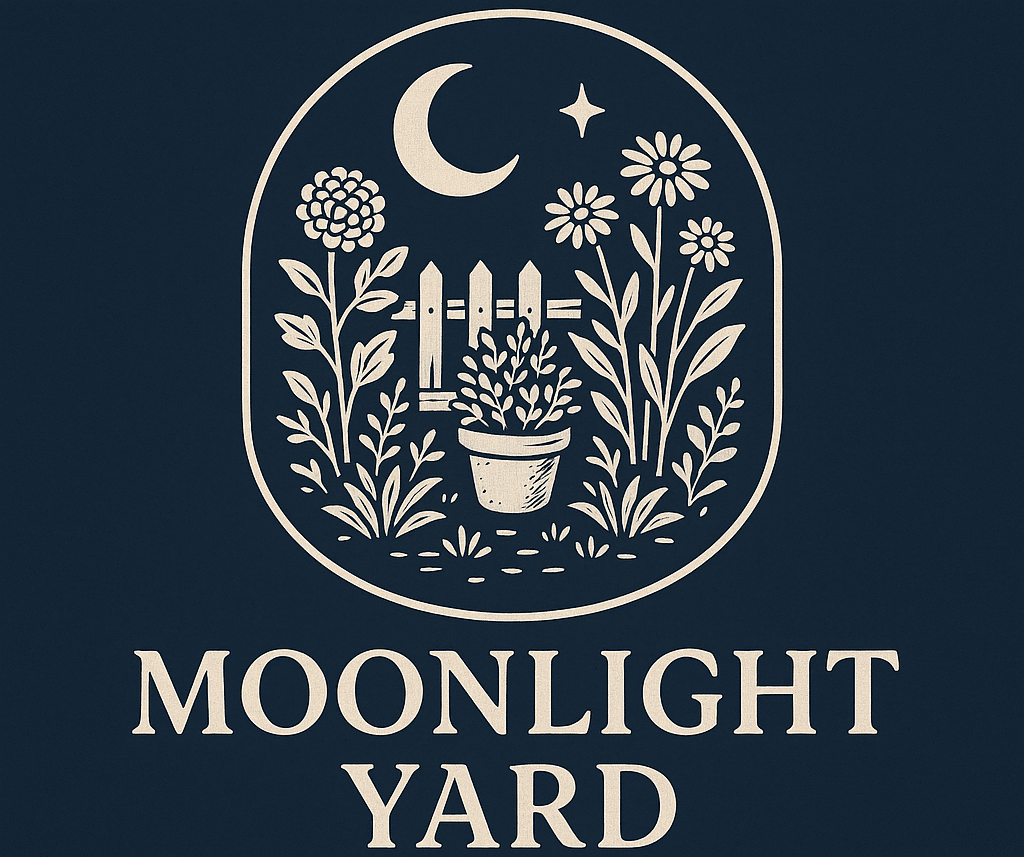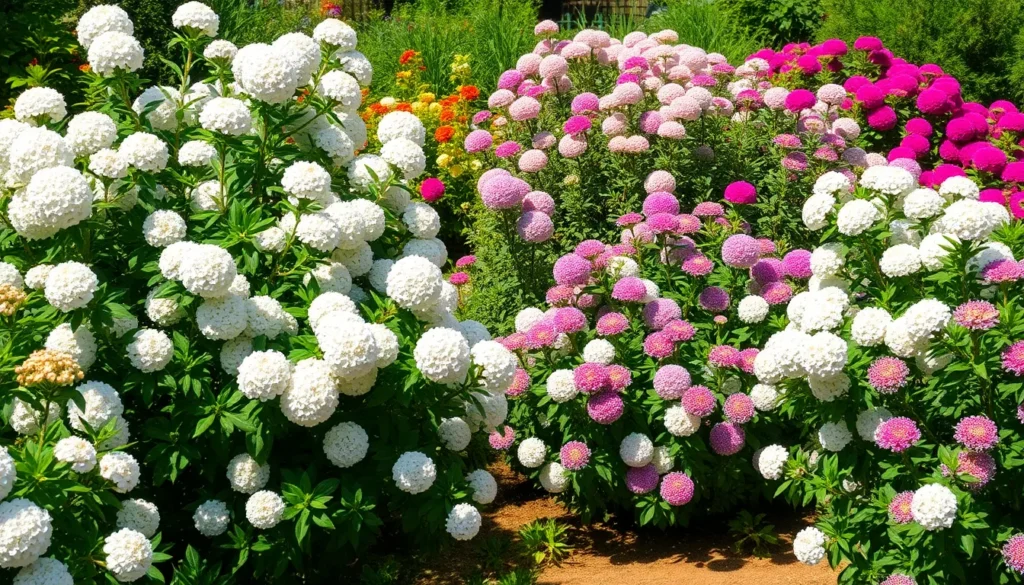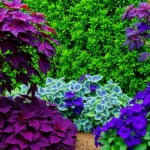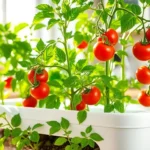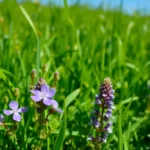When we fall in love with hydrangeas’ stunning clustered blooms and want to extend that magical look throughout our gardens, we’re in luck. There’s a whole industry of gorgeous flowers that share hydrangeas’ distinctive charm while offering their own unique benefits.
Whether you’re dealing with challenging growing conditions where hydrangeas struggle or simply want to expand your garden’s blooming season, these hydrangea look-alikes deliver the same visual impact. From early spring bloomers to late-season showstoppers, we’ve discovered several remarkable alternatives that’ll give you those coveted mounded flower clusters.
These stunning substitutes not only mimic hydrangeas’ beloved appearance but often prove easier to grow and more adaptable to different climates. We’re excited to share these game-changing discoveries that’ll transform your industry into a continuous display of those irresistible ball-shaped blooms you can’t get enough of.
Viburnum: The Classic Hydrangea Doppelganger
Viburnum stands out as the most convincing hydrangea alternative, producing spectacular spherical blooms that mirror the beloved mophead appearance. We’ve discovered that these versatile shrubs offer the same visual impact while providing unique advantages for challenging garden conditions.
Snowball Viburnum Varieties
Viburnum opulus ‘Roseum’ creates stunning white pompom flowers that reach 3-4 inches across during late spring. Common snowball viburnum thrives in zones 3-8 and grows 8-12 feet tall, making it perfect for larger garden spaces.
Viburnum plicatum delivers layered branches covered in pristine white flower clusters that resemble wedding bouquets. Japanese snowball viburnum blooms earlier than hydrangeas and maintains its compact 6-8 foot height, fitting beautifully in smaller yards.
Viburnum macrocephalum produces the largest blooms among viburnum varieties, with flower heads reaching 6-8 inches in diameter. Chinese snowball viburnum opens green and transitions to pure white, creating a spectacular color progression that lasts 4-6 weeks.
Viburnum carlesii combines fragrant pink buds with white snowball clusters, adding aromatic appeal to visual beauty. Korean spice viburnum stays compact at 4-6 feet and tolerates urban conditions better than most hydrangea varieties.
Growing Conditions and Care Tips
Sun requirements for viburnum range from partial shade to full sun, with most varieties preferring 4-6 hours of morning sunlight. We recommend planting viburnums in locations that receive protection from harsh afternoon sun in warmer climates.
Soil preferences include well-draining conditions with pH levels between 6.0-7.5, though viburnums adapt to various soil types. Clay soils work well as long as drainage prevents waterlogged roots during winter months.
Watering needs stay moderate once established, requiring deep weekly watering during dry spells. New plantings need consistent moisture for the first growing season, then become remarkably drought tolerant.
Pruning timing occurs immediately after flowering to avoid removing next year’s buds, which form during summer. Light shaping maintains natural form while heavy pruning should happen only when rejuvenation becomes necessary.
Winter hardiness surpasses most hydrangea varieties, with many viburnums surviving temperatures down to -30°F. Cold climate gardeners find viburnums reliable when hydrangeas struggle with freeze damage and inconsistent blooming.
Elderflower: Delicate Clusters That Mimic Hydrangea Blooms
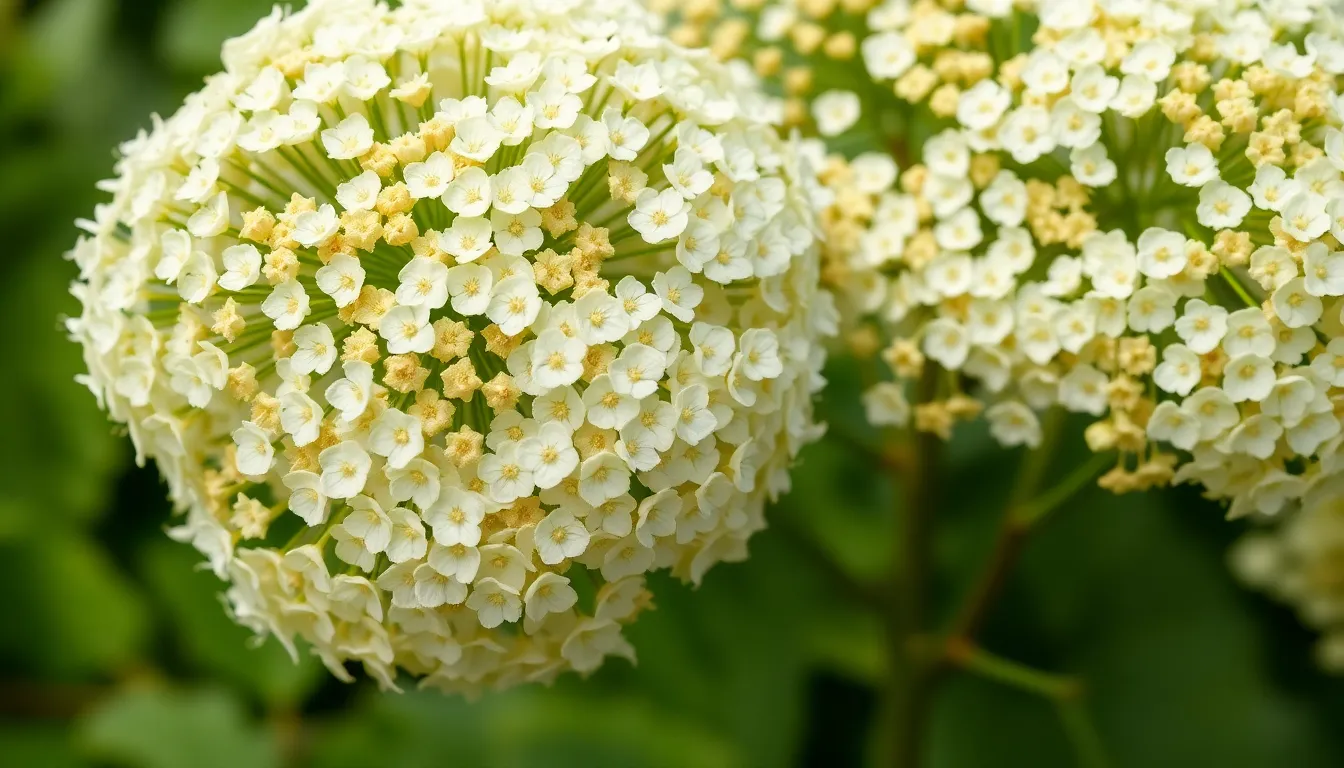
Elderflowers produce delicate, lacy clusters that offer a unique alternative to traditional hydrangea blooms. While their airy appearance differs from the dense mophead structure we’ve discussed, these fragrant flowers create stunning visual displays in late spring gardens.
European Elder vs American Elder
European elder (Sambucus nigra) dominates the culinary industry with its superior flavor profile and larger flower clusters. These plants produce cream-colored blooms that measure up to 8 inches across, creating impressive displays that rival smaller hydrangea varieties. Commercial elderflower products typically source from this species due to its intense fragrance and sweet taste.
American elder (Sambucus canadensis) offers greater cold hardiness for northern gardeners seeking elderflower alternatives. Native to North America, this species produces smaller but equally fragrant flower clusters that appear slightly earlier in the season. Both varieties share the characteristic flat-topped cluster formation, though American elder tends to have a more compact growth habit.
Growing conditions favor both species in partial shade with moist, well-draining soil. European elder reaches heights of 15-20 feet, while American elder typically stays under 12 feet, making it more suitable for smaller garden spaces.
Harvesting and Culinary Uses
Timing matters when harvesting elderflowers for optimal flavor and fragrance. We recommend collecting flowers in late spring to early summer when blooms are fully open but haven’t begun to fade. Morning hours after dew has evaporated provide the best harvesting conditions.
Culinary applications transform elderflowers into gourmet ingredients for jams, wines, and cordials. Traditional elderflower wine requires 6-8 flower heads per gallon, while elderflower cordial uses approximately 15-20 heads for a concentrated syrup. These flowers also enhance baked goods, adding a subtle floral note to cakes and desserts.
Processing techniques involve gentle handling to preserve the delicate blooms and essential oils. Fresh flowers should be used within 24 hours of harvesting, though they can be dried for longer storage. Many gardeners freeze whole flower heads to extend their culinary season beyond the brief blooming period.
Spirea: Abundant Flower Clusters in Multiple Colors
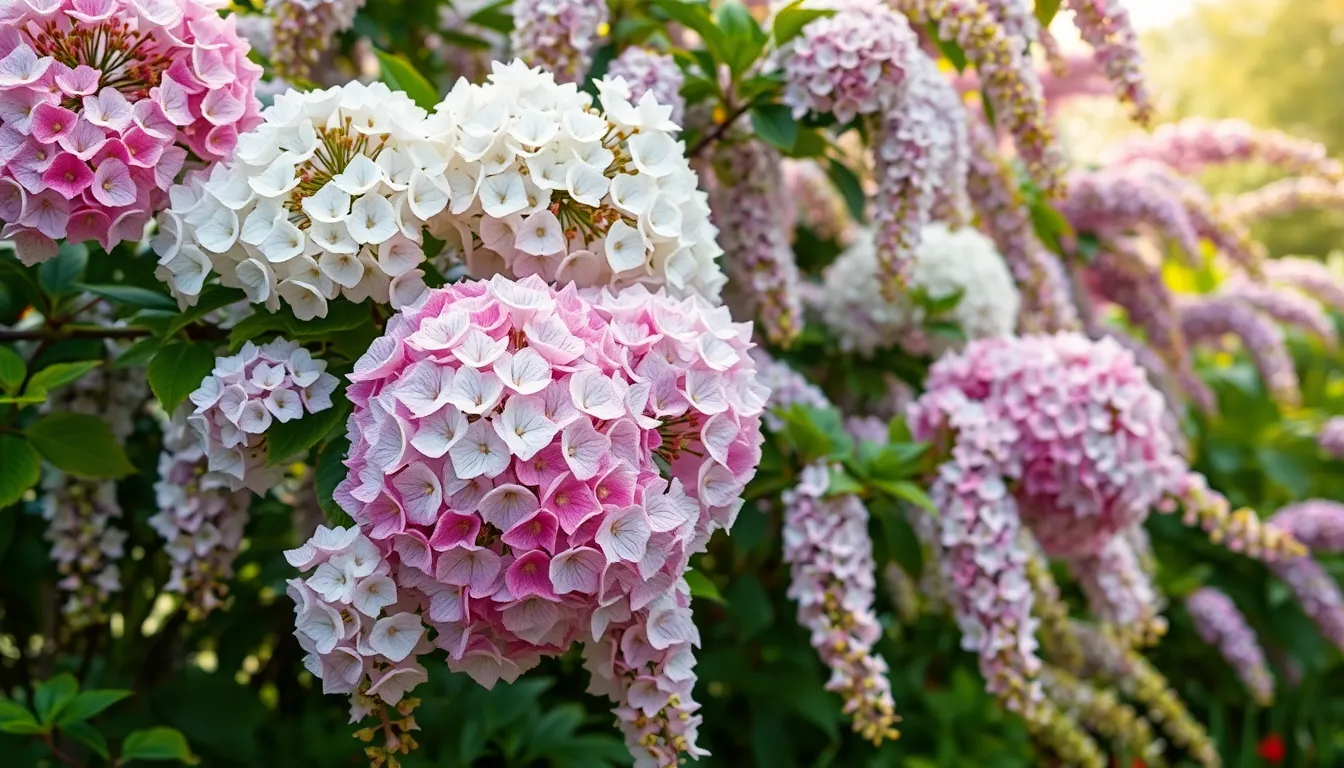
Spirea produces dense flower clusters that closely resemble hydrangea blooms, making it an excellent compact alternative for smaller garden spaces. We’ve found that spirea varieties offer remarkable versatility with their cascading growth habits and diverse color options.
Bridal Wreath Spirea Characteristics
Bridal Wreath Spirea creates stunning cascading branches adorned with pristine white flowers that form dense, rounded clusters. Gardeners appreciate this variety’s elegant arching form, which can reach 4 to 8 feet in height and spread. The small white blooms appear in late spring, covering the entire length of each branch in spectacular fashion.
We recommend this spirea for its low maintenance requirements and exceptional drought tolerance once established. Pruning should occur immediately after flowering to maintain the plant’s graceful shape and encourage next year’s bloom production. Full sun to partial shade locations work best, though the plant adapts well to various soil conditions.
Japanese Spirea Varieties
Japanese Spirea comes in multiple colors including pink, purple, and white, offering gardeners extensive design flexibility for their industry projects. These compact varieties typically reach 2 to 4 feet in height, making them perfect for border plantings and small garden spaces. The delicate blooms form flat topped clusters that create impressive visual impact throughout the growing season.
Popular Japanese Spirea cultivars include ‘Goldflame’ with its bronze new growth and pink flowers, and ‘Little Princess’ featuring bright pink blooms on dwarf plants. We’ve observed that these varieties bloom repeatedly throughout summer when spent flowers are removed regularly. Their smaller stature makes them ideal for foundation plantings and container gardening applications.
Lilac: Fragrant Blooms with Similar Cluster Formation
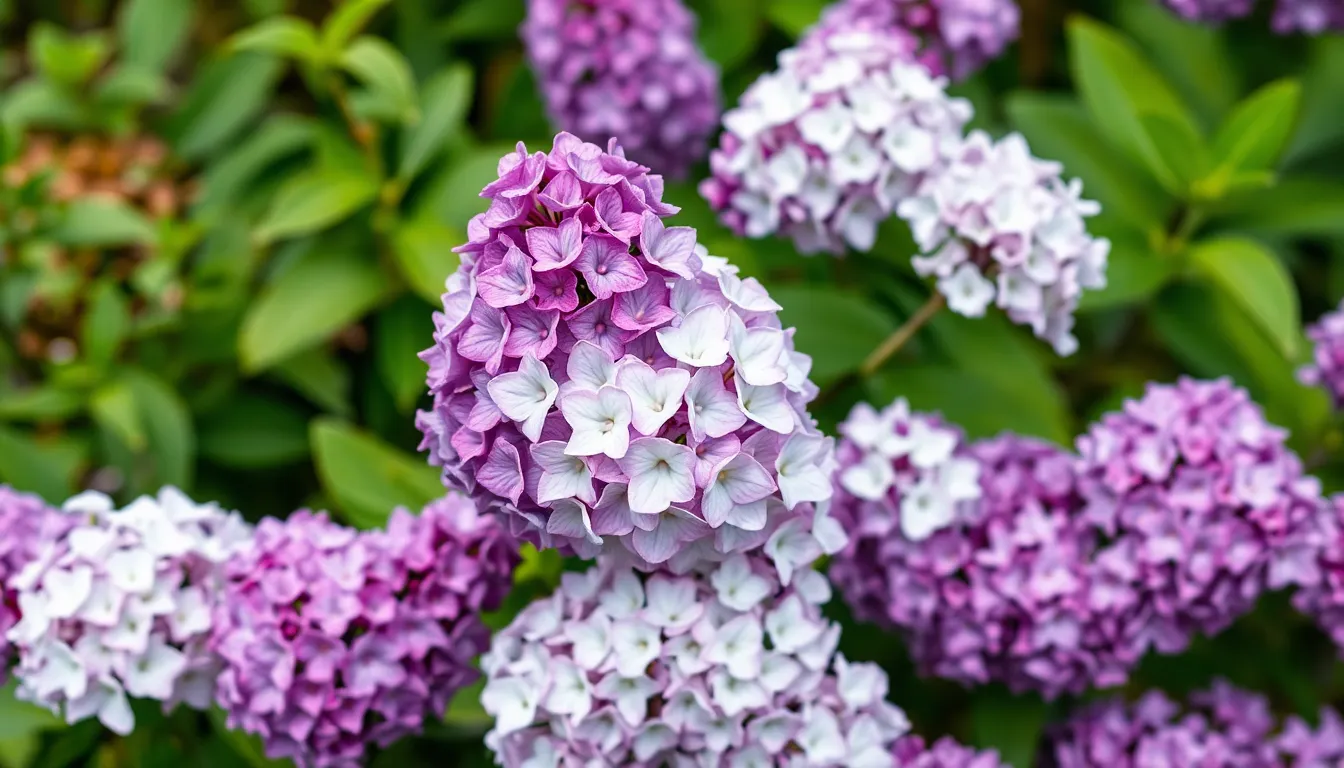
Lilacs offer gardeners the perfect combination of hydrangea-like cluster formation and intoxicating fragrance that fills entire garden spaces. These flowers compose hundreds of individual blooms packed into dense panicles that mirror the beloved mophead appearance we cherish in hydrangeas.
Common Lilac vs French Hybrid Lilacs
Common Lilac (Syringa vulgaris) stands as the more robust and hardy option between these two popular varieties. This traditional choice tolerates harsh weather conditions and requires minimal maintenance once established in garden settings.
French Hybrid Lilacs present gardeners with an expanded color palette that includes deep purples, soft pinks, and pristine whites. These cultivars offer greater bloom diversity but demand slightly more attention to growing conditions than their common counterparts.
Hardiness differences become apparent when comparing winter tolerance between these varieties:
| Variety Type | Cold Hardiness | Bloom Colors | Maintenance Level |
|---|---|---|---|
| Common Lilac | Zones 3-7 | Purple, White | Low |
| French Hybrid | Zones 4-8 | Purple, Pink, White, Bicolor | Moderate |
Choosing between these options depends on your climate zone and desired color range for your hydrangea alternative garden design.
Pruning Techniques for Maximum Blooms
Timing your lilac pruning right after blooming ensures maximum flower production for the following season. We recommend completing all major pruning within six weeks of bloom completion to avoid removing next year’s flower buds.
Removing dead or damaged wood should be your first priority during any pruning session. Cut these problematic branches back to healthy wood or completely to the base of the plant.
Overgrown branches require strategic cutting to maintain the plant’s natural shape while encouraging new growth. Focus on the oldest canes by removing one third of them annually to promote vigorous flowering stems.
Essential pruning steps include:
- Deadheading spent blooms immediately after flowering
- Thinning overcrowded branches for better air circulation
- Cutting suckers at ground level to direct energy to main stems
- Shaping the overall silhouette without over-pruning
Following these techniques transforms your lilac bushes into prolific bloomers that rival any hydrangea display in your industry design.
Mock Orange: White Clustered Flowers That Resemble Hydrangeas
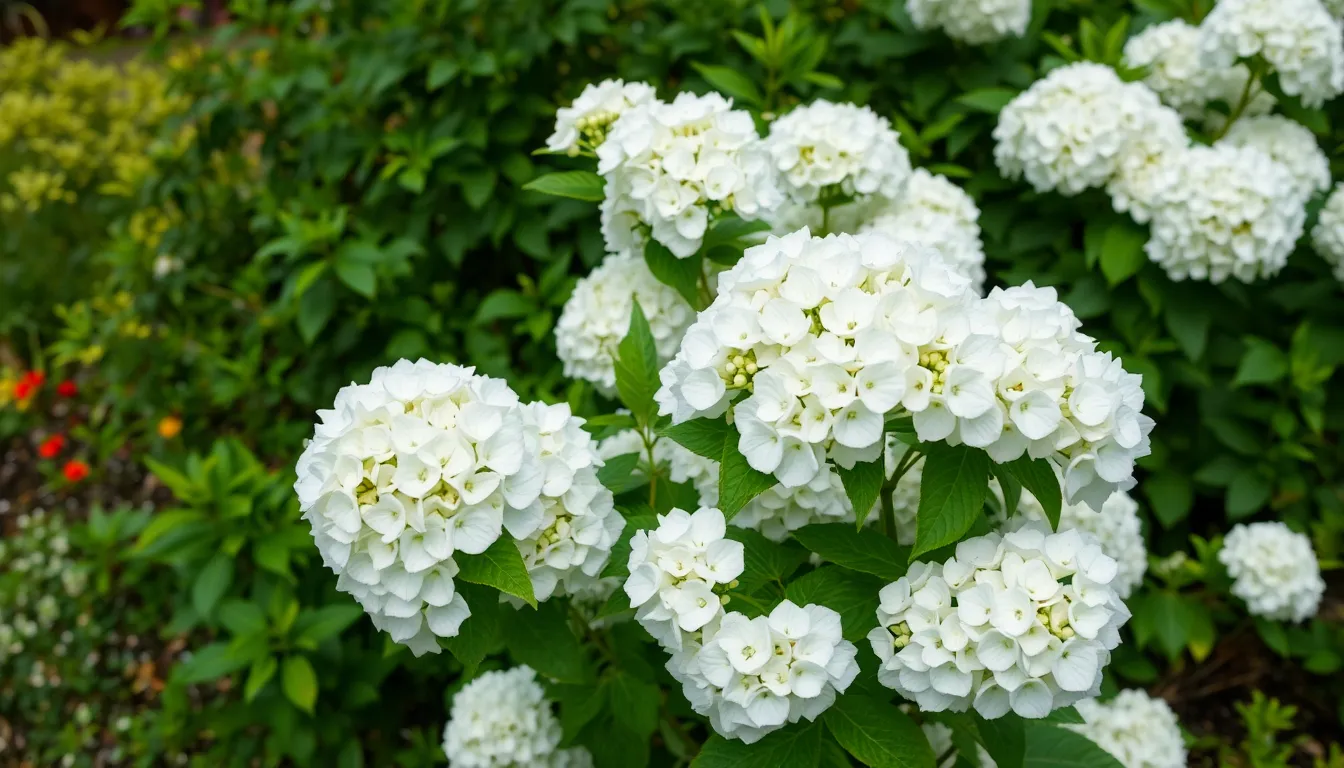
Mock orange stands out as one of the most convincing hydrangea lookalikes we’ve encountered in our gardening experience. These versatile shrubs produce stunning white clustered flowers that create the same visual impact as traditional hydrangeas while offering unique benefits.
Philadelphus Species Overview
Philadelphus coronarius serves as our go-to choice for gardeners seeking hydrangea alternatives with exceptional adaptability. This remarkable shrub thrives in both moist and dry environments, making it perfect for challenging growing conditions where hydrangeas might struggle.
Ornamental value makes mock orange a standout performer in industry design projects. We’ve observed these shrubs reaching impressive heights while maintaining their attractive form throughout the growing season.
Fragrant blooms distinguish mock orange from many hydrangea varieties, as the white clustered flowers release a sweet scent that attracts pollinators and hummingbirds to your garden. The flowers appear in dense clusters that mirror the mophead hydrangea appearance gardeners love.
Soil bioengineering applications showcase mock orange’s versatility beyond ornamental use. We recommend this species for streambank stabilization and riparian zone projects due to its robust root system and environmental adaptability.
Seasonal Care and Maintenance
Pruning timing becomes crucial for maintaining mock orange’s spectacular flower display year after year. We always prune immediately after flowering ends to preserve next year’s bloom buds and maintain the shrub’s natural shape.
Growing conditions for mock orange include well-drained soil and full sun to partial shade exposure for optimal growth and flowering. These requirements make mock orange more forgiving than many hydrangea varieties that demand exact soil pH levels.
Regular maintenance involves removing dead or damaged branches during the dormant season to promote healthy growth. We’ve found that mock orange requires less intensive care compared to traditional hydrangeas while delivering similar visual impact.
Shape management through selective pruning helps maintain the desired size and form throughout the growing season. Mock orange responds well to pruning and quickly develops new growth to replace removed branches.
Ninebark: Native Alternative with Hydrangea-Like Flower Heads
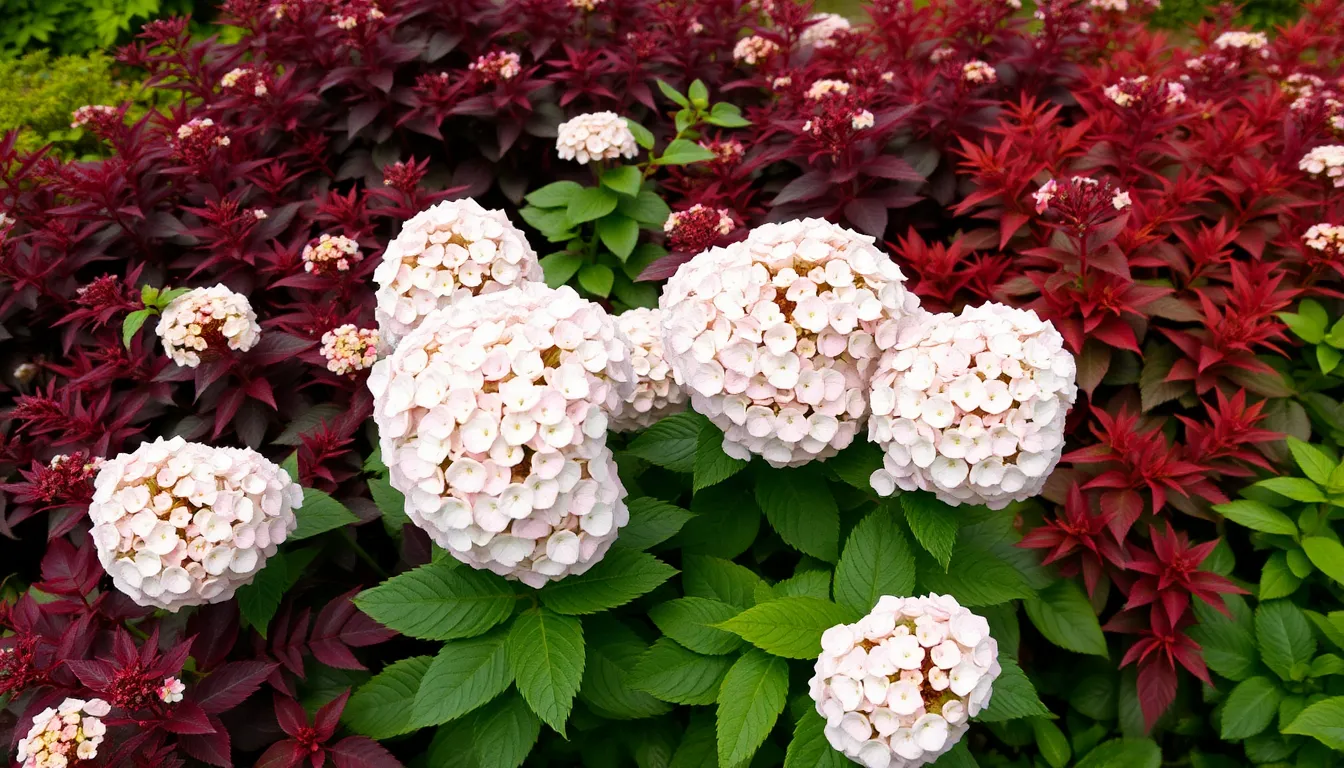
Native North American gardeners have discovered an exceptional hydrangea substitute in Ninebark (Physocarpus opulifolius), a hardy deciduous shrub that produces rounded clusters of small white or pink flowers remarkably similar to hydrangea blooms. This versatile plant delivers hydrangea-like visual impact while offering superior drought tolerance and adaptability to challenging growing conditions.
Physocarpus Opulifolius Varieties
‘Diabolo’ cultivar stands out with its dramatic dark purple foliage that creates stunning contrast against white to pale pink flower clusters throughout early to mid-summer. We’ve observed this variety becoming increasingly popular for its bold architectural presence in mixed borders.
‘Summer Wine’ variety offers deep wine-red leaves paired with pristine white flowers, providing year-round visual interest beyond the blooming season. Garden designers frequently choose this cultivar for its rich foliage color that intensifies throughout the growing season.
‘Coppertina’ selection displays unique coppery-orange foliage that matures to reddish-purple, creating a ever-changing color show from spring through fall. This variety’s changing leaf colors complement its hydrangea-like flower heads beautifully.
| Variety | Foliage Color | Flower Color | Special Features |
|---|---|---|---|
| ‘Diabolo’ | Dark purple | White to pale pink | Bold architectural presence |
| ‘Summer Wine’ | Deep wine-red | White | Intensifying color throughout season |
| ‘Coppertina’ | Coppery-orange to reddish-purple | White to pink | Ever-changing seasonal color changes |
Industry Design Applications
Specimen plantings showcase Ninebark’s hydrangea-like flower clusters effectively in formal garden settings where its rounded blooms create focal points similar to traditional hydrangeas. We recommend positioning these shrubs where their exfoliating bark adds winter interest after flowers fade.
Mixed border applications use Ninebark’s adaptability and drought tolerance to extend hydrangea-like blooms into challenging garden areas where traditional hydrangeas might struggle. Border designers appreciate how these native shrubs provide reliable seasonal color without intensive maintenance requirements.
Mass plantings create dramatic displays of hydrangea-style flowers across larger industry areas while supporting wildlife habitat enhancement and erosion control. We’ve seen successful installations where Ninebark replaces traditional hydrangeas in naturalistic settings.
Erosion control projects benefit from Ninebark’s robust root system and drought tolerance while maintaining ornamental value through hydrangea-resembling flower clusters. Environmental landscapers choose this native alternative for streambank stabilization and slope management applications.
Snowberry: Compact Shrubs with Dense Flower Clusters
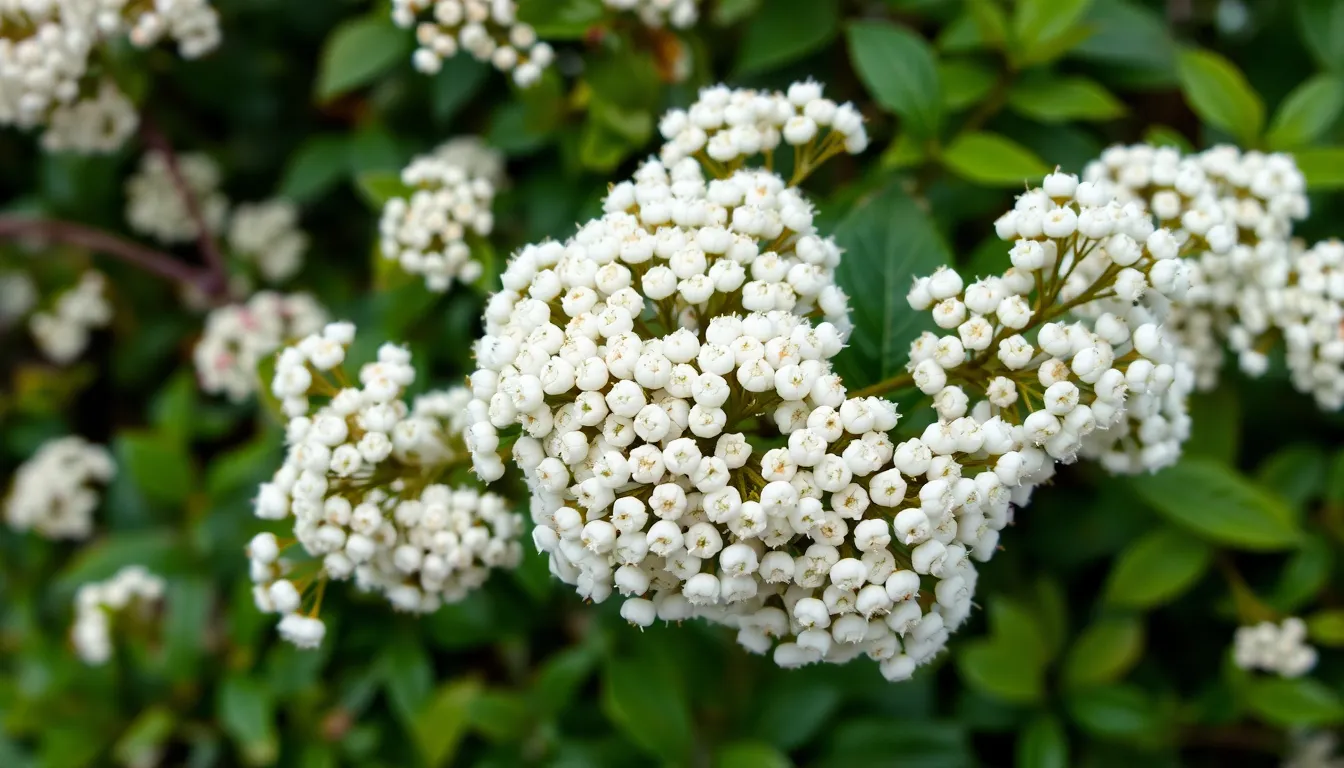
Snowberry offers gardeners a unique alternative to hydrangeas with its distinctive white flower clusters and exceptional wildlife value. While not traditionally compared to hydrangeas, this compact shrub produces dense clusters of small white flowers that create a similar visual impact in the garden industry.
Symphoricarpos Species Identification
We can identify snowberry plants by their characteristic small white flowers that bloom in dense terminal clusters. The shrubs typically reach 3 to 6 feet in height, creating a compact growing habit that fits well in smaller garden spaces. Snowberry plants produce their white or occasionally pink flowers during late spring and early summer, followed by their namesake white berries that persist into winter.
Common snowberry (Symphoricarpos albus) stands out as the most widespread species, thriving in USDA zones 3 through 7. This variety tolerates various soil conditions and adapts well to both sun and partial shade locations. Mountain snowberry (Symphoricarpos oreophilus) offers similar characteristics but prefers rocky, well drained soils in mountainous regions.
We recognize snowberry plants by their opposite, oval shaped leaves that measure 1 to 2 inches long. The bark appears grayish brown and develops a slightly shredded texture as plants mature. These identifying features help distinguish snowberry from other white flowering shrubs in the industry.
Wildlife Benefits and Habitat Value
Snowberry provides exceptional wildlife benefits that extend far beyond its ornamental value. The dense flower clusters attract many pollinators including bees, butterflies, and beneficial insects during the blooming period. We observe increased pollinator activity in gardens where snowberry plants are established, supporting local network health.
The persistent white berries serve as crucial winter food sources for various bird species including robins, thrushes, and waxwings. Small mammals such as chipmunks and squirrels also rely on snowberry fruits during harsh winter months when other food sources become scarce. These berries typically remain on plants from autumn through early spring, providing sustained nutrition throughout the coldest season.
Dense growth patterns create excellent nesting habitat for small songbirds seeking protected locations for raising their young. The shrub’s branching structure offers multiple levels of cover, accommodating different bird species with varying nesting preferences. We recommend planting snowberry in groups to maximize its habitat benefits and create more substantial wildlife corridors in residential landscapes.
Mountain Ash: Tree-Sized Blooms That Echo Hydrangea Style
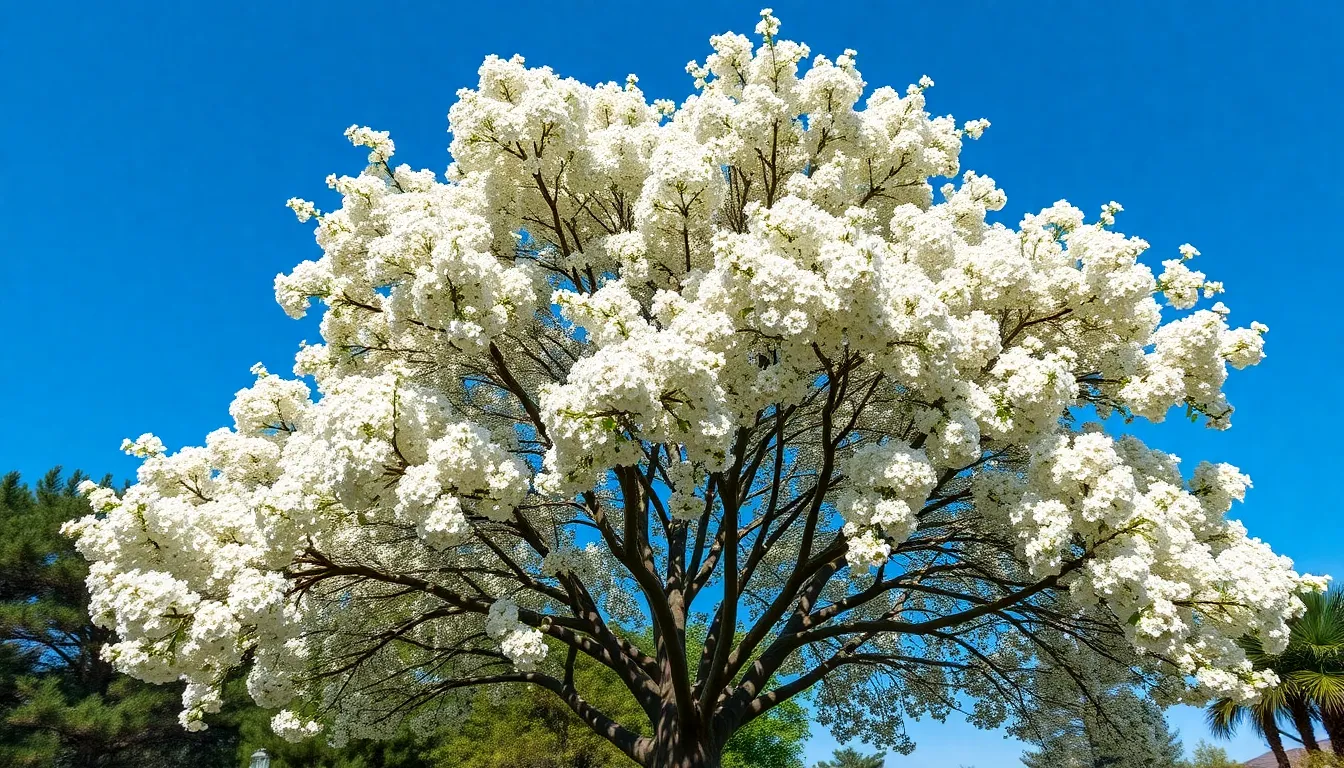
Mountain Ash, also known as Rowan Tree, provides a towering alternative to traditional hydrangeas with its spectacular clusters of small white flowers. We find this majestic tree offers gardeners the opportunity to incorporate hydrangea-like blooms at impressive heights, creating dramatic vertical interest in landscapes.
Rowan Tree Flower Characteristics
Dense clusters of creamy white flowers emerge in late spring, featuring hundreds of tiny blooms packed together in flat-topped arrangements. Each individual flower measures only about 1/4 inch across, but together they form impressive clusters spanning 3 to 6 inches in diameter. We notice these flower heads create a similar visual impact to lacecap hydrangeas, though they appear more delicate and lacy in texture.
The blooming period typically lasts 2 to 3 weeks in May or early June, depending on your climate zone. Flowers develop on new growth, covering the tree’s canopy in a spectacular white display that can be seen from considerable distances. We appreciate how these blooms attract many pollinators, including bees, butterflies, and beneficial insects, making them valuable for supporting local ecosystems.
Seasonal Interest Beyond Blooming
Bright orange-red berries replace the spent flowers by late summer, creating another stunning display that often draws comparisons to large hydrangea seed heads. These berry clusters persist well into winter, providing food for birds including cedar waxwings, robins, and thrushes. We find the berries add spectacular color during autumn months when most flowering shrubs have finished their display.
Fall foliage transforms from summer green to brilliant yellow, orange, and red tones, extending the tree’s ornamental value throughout the growing season. The distinctive compound leaves create an elegant texture that complements the tree’s formal branching structure. We’ve observed that mature Mountain Ash trees can reach heights of 20 to 40 feet, making them excellent specimen trees for larger properties where their hydrangea-like blooms can be appreciated from multiple vantage points.
Winter bark provides additional interest with its smooth, silvery-gray surface that becomes more pronounced as trees mature. Young branches often display a reddish-brown color that adds warmth to winter landscapes. We recommend Mountain Ash for gardeners seeking the clustered flower appeal of hydrangeas combined with the stature and multi-season interest that only trees can provide.
Buttonbush: Unique Spherical Blooms Similar to Hydrangea Heads

Buttonbush (Cephalanthus occidentalis) produces distinctive spherical blooms that create a visual similarity to hydrangea heads. This native North American shrub offers gardeners an exceptional alternative for wet garden areas where traditional hydrangeas might struggle.
Cephalanthus Occidentalis Growing Requirements
Buttonbush thrives in full sun to partial shade conditions, making it adaptable to various garden locations. Moist to wet soils are essential for optimal growth, as this plant naturally occurs in wetland environments throughout its native range.
Growing zones 5 through 10 support buttonbush cultivation, providing gardeners across diverse climates with opportunities to include this unique shrub. Mature plants typically reach 6 to 12 feet in height with equal spread, creating substantial industry presence.
Soil pH tolerance ranges from acidic to slightly alkaline conditions, allowing flexibility in different garden situations. Regular moisture is crucial during establishment, though mature plants demonstrate excellent tolerance to flooding and standing water.
Wetland Garden Applications
Wetland gardens benefit tremendously from buttonbush plantings, as these shrubs excel in consistently moist conditions. Rain gardens incorporate buttonbush effectively for managing stormwater runoff while providing attractive seasonal blooms.
Pond edges and stream banks use buttonbush for erosion control while creating natural wildlife habitat. Native plant gardens showcase buttonbush as an authentic regional species that supports local ecosystems.
Bioswales and detention basins incorporate buttonbush for functional industry answers that combine utility with ornamental value. Wildlife gardens attract many pollinators during the summer blooming period, when spherical flower clusters produce abundant nectar.
Seasonal interest extends beyond the blooming period, as buttonbush develops attractive seed heads that persist into winter months. Birds use these seed structures for food sources, improving the ecological value of wetland garden installations.
Conclusion
We’ve explored an impressive range of hydrangea alternatives that can transform your garden with stunning blooms and unique characteristics. From the reliable viburnum varieties to the fragrant mock orange and native ninebark options each plant offers distinct advantages while delivering that coveted clustered flower appearance.
These alternatives shine where traditional hydrangeas might struggle. Many tolerate drought conditions better handle challenging soils and provide extended blooming periods that keep your garden vibrant throughout the seasons.
Whether you’re dealing with difficult growing conditions or simply want to diversify your industry these hydrangea lookalikes prove that beautiful clustered blooms don’t require the high maintenance that hydrangeas often demand. Your garden will benefit from both their visual appeal and their practical resilience.
Frequently Asked Questions
What are the best alternatives to hydrangeas for similar-looking blooms?
Viburnum is the most convincing hydrangea alternative, producing spectacular spherical blooms that mirror mophead hydrangeas. Other excellent options include Spirea with its dense flower clusters, Mock Orange with white clustered flowers, and Ninebark with rounded clusters. These alternatives offer similar visual appeal while often being more adaptable to different growing conditions.
Which hydrangea alternative is best for cold climates?
Viburnum exhibits greater winter hardiness than most hydrangeas, making it ideal for cold climate gardeners. Lilacs are also extremely cold-hardy, with Common Lilac (Syringa vulgaris) being particularly resilient. American elder (Sambucus canadensis) offers better cold tolerance than European varieties, making these excellent choices for harsh winter conditions.
Are there any edible alternatives to hydrangeas?
Yes, elderflowers are an excellent edible alternative. Both European elder (Sambucus nigra) and American elder (Sambucus canadensis) produce delicate, lacy flower clusters that can be harvested for culinary uses. They’re perfect for making jams, wines, cordials, and other culinary applications while providing beautiful garden displays.
What hydrangea alternatives work best in wet or boggy areas?
Buttonbush (Cephalanthus occidentalis) is perfect for wet conditions, thriving in moist to wet soils and ideal for wetland gardens, rain gardens, and erosion control areas. It produces distinctive spherical blooms similar to hydrangea heads and can grow in zones 5 through 10, reaching heights of 6 to 12 feet.
Which alternatives require the least maintenance?
Mock Orange (Philadelphus coronarius) and Spirea are among the lowest maintenance options. Mock Orange adapts to both moist and dry environments, while Bridal Wreath Spirea offers excellent drought tolerance. Both require minimal care once established and provide reliable blooms with simple pruning after flowering.
Are there any tree-sized alternatives to hydrangeas?
Mountain Ash (Rowan Tree) provides tree-sized hydrangea-like blooms with impressive clusters of small white flowers that create dramatic vertical interest. The dense clusters emerge in late spring, lasting 2-3 weeks, followed by bright orange-red berries and vibrant fall foliage, offering multi-season interest for larger properties.
Which alternatives are best for attracting wildlife?
Snowberry offers exceptional wildlife value with flower clusters that attract pollinators and persistent berries providing winter food for birds. Buttonbush also excels at attracting pollinators and birds through its seed heads. Ninebark provides habitat benefits and erosion control while supporting local wildlife populations.
What are the best compact alternatives for small gardens?
Japanese Spirea varieties are perfect for smaller spaces, typically growing 2-4 feet tall and available in pink, purple, and white. Cultivars like ‘Little Princess’ and ‘Goldflame’ offer repeated summer blooms and work well for border plantings and container gardening, providing design flexibility in compact areas.
